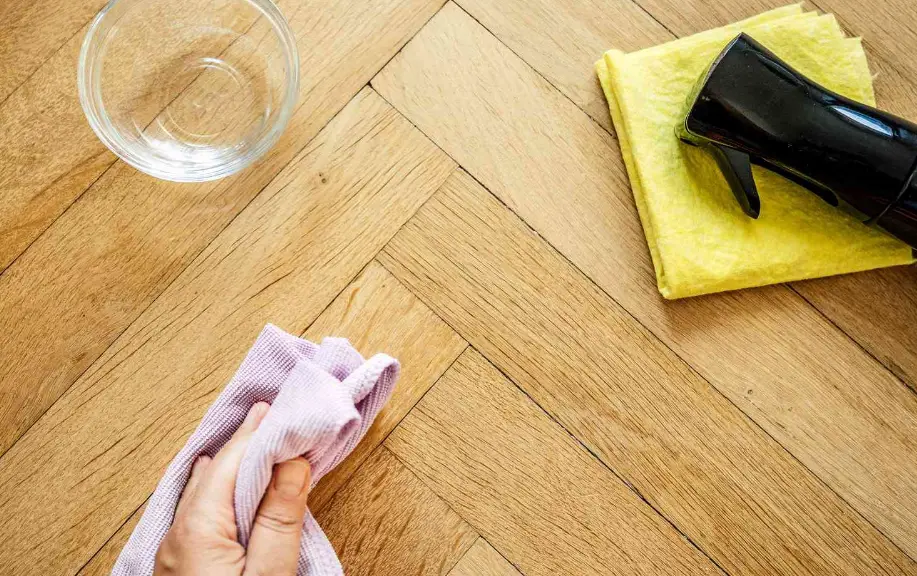In this article, we will talk about how to get wax off hardwood floor. Hardwood floors are becoming more and more in demand because of the eco-friendliness and subtlety of the style you can give your home. Wax on hardwood floors is not susceptible to hardening.
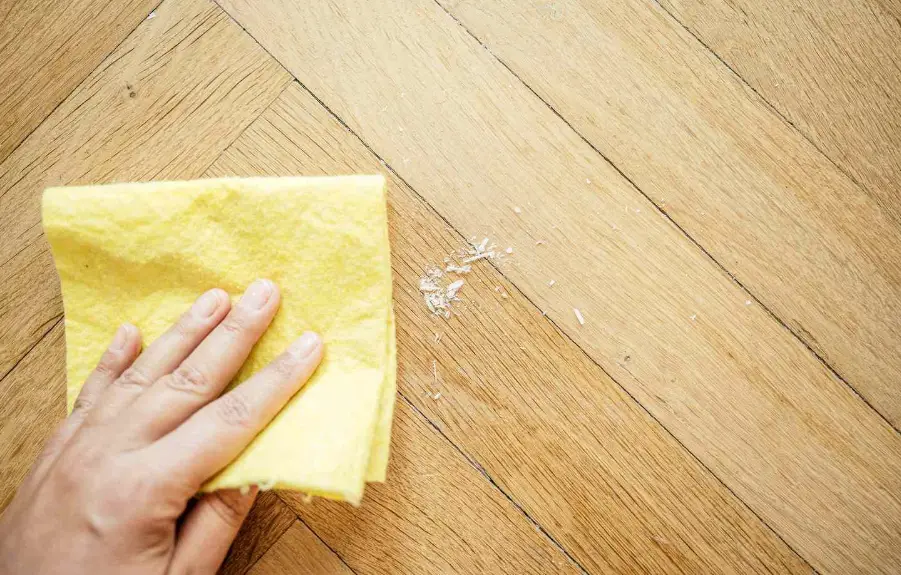
What happens over time is that a huge amount of dirt accumulates on the wax and the coating becomes unsightly. We have gathered all the methods and tips for removing wax deposits from wooden floors.
To remove wax buildup from wooden floors, buy an odorless alcohol solvent that will handle the wax without damaging the flooring. Dip a rag into the mineral spirits.
Divide the floor into small areas and work in stages, occasionally adding little mineral spirits to the rag. After cleaning, use a cotton pad to wipe down the fresh area.
It won’t cost you much to remove the wax. You don’t need a lot of tools and materials to remove the wax buildup and do a good job. We will tell you what to use and when to use it.
Solvent for Removing Wax Buildup
To know well how to remove wax deposits from wood floors, you need to understand the composition of floor waxes.
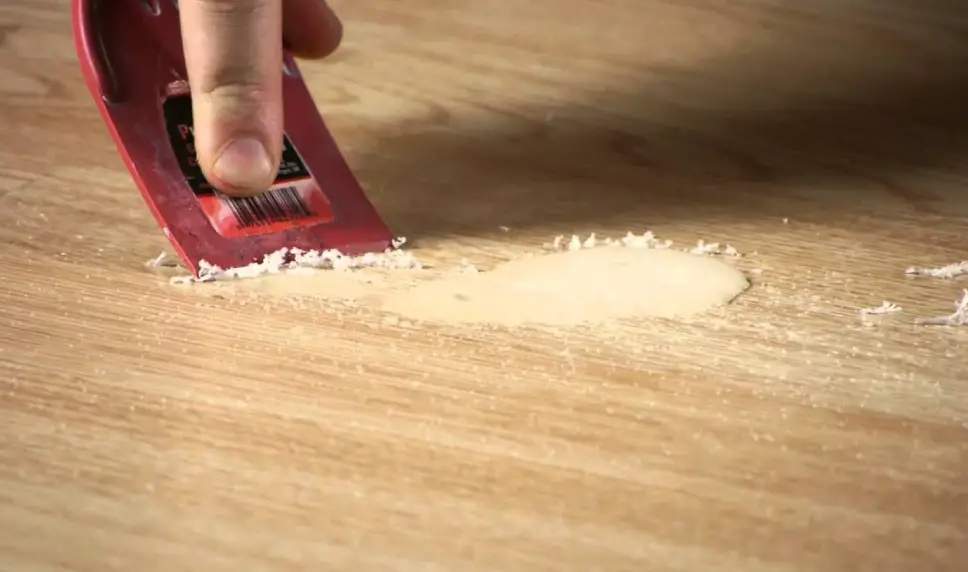
Although many types of waxes are not alike, the main brands contain an emulsion of paraffin or carnauba in a solvent.
When the wax is applied, the solvent dissolves quickly and you can only observe a waxy finish. The wax does not become overly hard and retains a slight softness.
You can, of course, try scraping the wax off the floor with something sharp or a construction spatula, but this will take a very long time, and more often than not this is how you can cause irreparable damage to the floor finish.
The most productive way to remove wax buildup is to add solvent to the wax and wipe it off.
What Dissolves Wax Buildup
The most effective solvent for dissolving wax is mineral spirits. Mineral spirits are substances that create the familiar waxy smell.
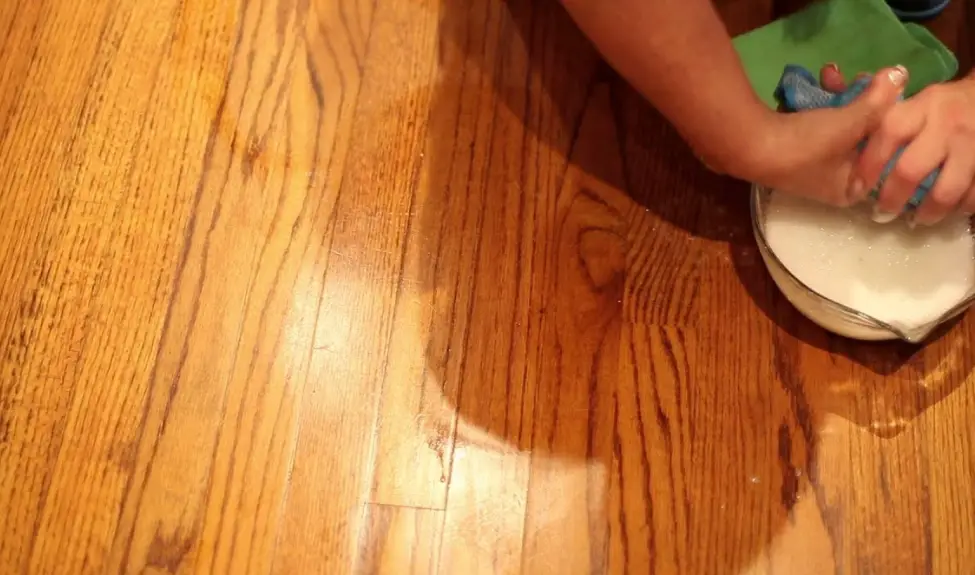
More familiar solvents, such as acetone, also help to remove wax, but they are very damaging to the finish. We don’t advise you to use them.
Hot water also helps the wax to dissolve, most often if you add vinegar, laundry detergent, or any floor cleaner to it, but we also advise you not to go the same way.
If you forget about hot water on a wooden floor or just leave it to dissolve the wax for a long time, the water will penetrate into the pores of the wood, causing it to swell and damage the floor.
We also advise against buying any water-based cleaners.
6 Easy Steps to Remove Wax Buildup
Removing wax buildup is a time consuming process if you own a large area of hardwood flooring.
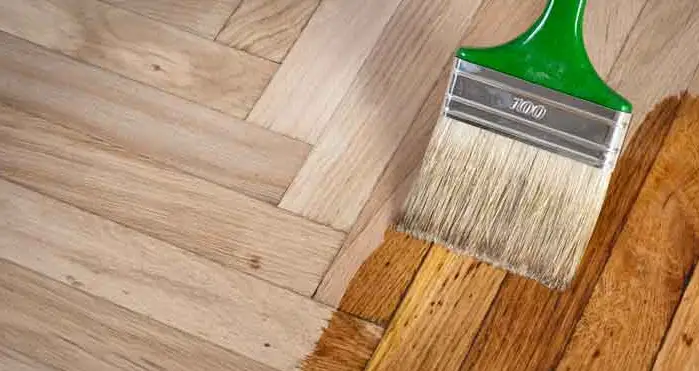
We hasten to disappoint you, there are no quick options to remove wax instantly. If you only need to remove wax in small areas, it will not take long. But if you need to work on the entire flooring, it can take you four to six hours.
Rub with Mineral Spirits and Soft Cloth
Take a broom and sweep up all excess debris to clean the work surface. Then run a dry mop with a microfiber mop, then vacuum thoroughly with a special nozzle. You need to get rid of dust as much as possible.
Take a spray bottle and fill it with mineral spirits. Remember that alcohols when used quickly evaporate and turn into volatile organic compounds, so in the process of cleaning we advise to ventilate the room constantly. If you are allergic to these compounds, it is advisable to buy a respirator.
Dip the cloth in mineral spirits. Use the sprayer to go through all the crevices on the floor so that the wax will dissolve in them as well. Remember to divide it into sections and treat a small area first.
It is advisable to start at the far corner of the room and gradually move toward the exit. Mineral spirits should be rubbed in the direction of the wood grain. The wax will stick to the cloth in the process. When the cloth gets very dirty, simply change it for another.
Gradually, as the wax fades, you will be able to see that the cloth is rapidly yellowing. When the cloth after wiping will not contain yellowing, then you have done the job. Continue section by section until all the wax is gone.
Rub Hardwood Floors with Mineral Spirits and Steel Wool
Once you’ve wiped off all the wax and it’s clean, it’s time to proceed to the next step. Dip a thin steel wool in mineral spirits and go over the clean area of the wood floor. You need to move toward the texture of the wood.
You will have a good go at going over all the hard-to-reach places and grooves with the steel wool.
After you get rid of the layer of wax in one area, move on to cleaning the next area.
Always stick to the plan prepared in advance, so you know where you have already been and what part of the floor has not yet been cleaned. Knee pads are worth buying to protect your knees as you wax your hardwood floors.
Mop Hardwood Floors with Hot Water
When the entire wood floor is cleaned of stale wax, arrange a final cleaning cycle by rinsing the wood floor surface with a warm stream of water.
Make sure to wipe off any remaining water with a cloth, as it can quickly destroy the hardwood floor coating.
Use a mop on different sections and work the surface with a dry microfiber cloth on a dry mop to completely remove all water stains.
Tough Stain Removal
1. If it is an older floor, there may be some more serious dirt. Apply mineral spirits to the stain spot.
2. Carefully scrub the stain with a putty knife or scrub with a toothbrush.
3. Wipe off the stain with a dry cloth and re-treat if desired.
Allow the Hardwood Floors to Dry
Make sure that time is allowed to dry before a new coat is applied. After the waxing process is completed, the floor surface should be completely clean, dry, and suitable for re-scrubbing.
Refinish the Hardwood Floors
When re-coating your floor with another coat of wax, read the labeling and follow the manufacturer’s recommendations.
If you are not going to re-wax your hardwood floor, you have the option of using a polyurethane coating.
Polyurethane is more durable than a wax coating and may be more sustainable and long-lasting if you intend to avoid wax build-up in the future. However, do not coat the floor with polyurethane before you have checked that the wax has been permanently removed.
How to Carefully Remove Candle Wax from Hardwood Floors: Some Effective Ways
A romantic evening, a candlelit dinner, a beautiful bouquet, and a bottle of champagne – everything is so beautiful that it reminds one of a fairy tale.
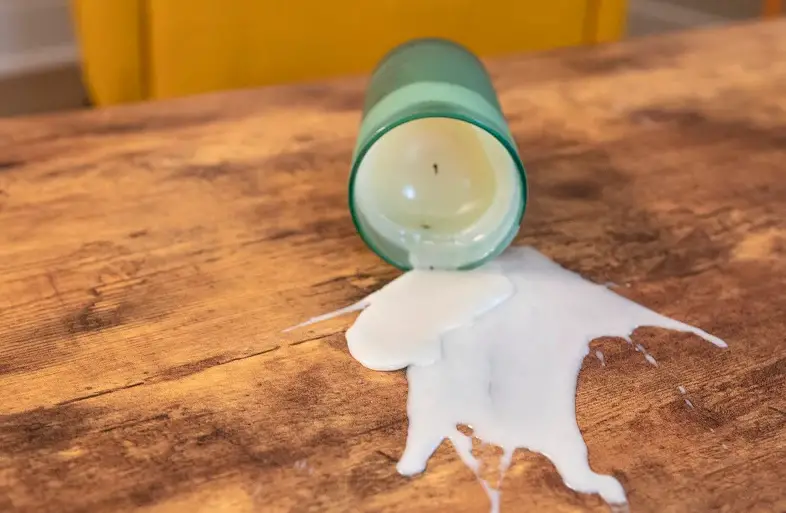
But, just like in the fairy tale, in the morning there is something to be surprised and disappointed about – it’s stains of candle wax on the floor. How to get rid of them now, and will trace remain on the parquet or linoleum?
If the candle wax is not removed from the surface of the flooring immediately, then coping with the candle wax stain will be quite difficult. To remove it from your parquet, you need to use the quick freeze method.
Step-by-step Instructions
First, use an ice cube to harden the wax droplets. This is one way to remove wax from wood floors with minimal scraping.
Simply hold the ice cube in place of the soiling for thirty seconds. If the wax drop is fresh and still pliable, you may need more time: a minute or even two.
Use a credit card or a thin razor blade, if you have one handy, to scrape off the frozen drops of candle wax. Refreeze the stain if the dirt can’t be removed from the floor.
Polish the floor after removing the candle wax droplets.
Wipe the area dry with a clean cloth. Be sure to collect all the water that has melted from the ice cubes! If there are still traces of wax on the surface, clean a wide area of the floor with wood furniture wax to cool off any remaining dirt.
It may seem pointless to you to use wax to remove a wax stain. In fact, your fears are in vain. Furniture wax is specifically designed to help get rid of surface imperfections and provide protection for wood products.
Polishing an extensive area, rather than a small affected area, helps make the surface where the stain was located less noticeable.
Use a hair dryer
Turn the device on, set it to medium mode, and aim it at the wax droplets. It is very important to hold the hair dryer at a distance of 20-30 centimeters from the dirt. The heat will help soften the wax. It will make it easier for you to scrape the wax off the floor without damaging the surface.
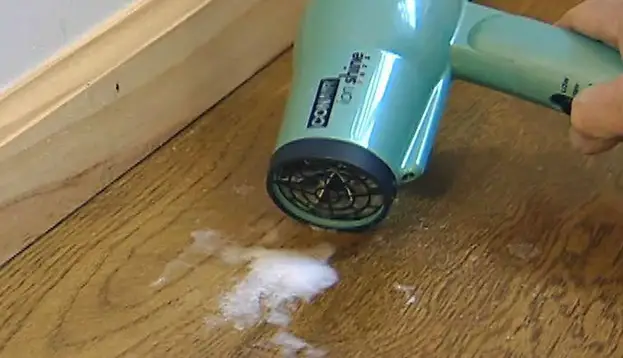
When the wax has softened, use the edge of a plastic credit card or razor blade to remove the stain from the wood floor surface.
If there are still traces of wax on the surface of your hardwood floors, finish the cleaning process by applying wood furniture wax to polish and clean the entire damaged area. This process will help remove any residual dirt and help re-polish your floors.
Removing Stubborn Wax Buildup from Hardwood Floors
If the above cleaning method has failed to remove the wax buildup from the floor surface, you’re probably wondering what else you can think of to restore your hardwood flooring. Don’t be alarmed, as you have no other choice!
Regardless of how long the wax has formed on your wood floors, it can be quite difficult to remove the murky film.
If the method outlined earlier has not been successful in removing the waxy buildup on your wood floors, you may have to have your wood floors sanded.
Sanding the floors will provide access to the wax plaque layer. This can be quite a hassle, though. For optimum effects in some cases of impenetrable wax plaque, it is worth turning to the services of a professional.
A professional will use a specialized disc sander for sanding hardwood floors. It is often a more reliable mechanism for sanding hardwood floors than a drum sander. If you don’t have the proper skill to use these tools, assign this task to a professional craftsman!
Sanding hardwood floors is a fairly harmless practice. Masters estimate that many hardwood floors can be sanded up to a dozen times. Sanding is often used to restore hardwood floors by adding an extra amount of protective coating.
Re-applying a Finish to Your Hardwood Floors
Hardwood floors wax is a protective agent for wooden floors that helps resist moisture, mechanical damage, and fading. With the help of this substance, you create a noble look on the flooring. An important factor is that the product is environmentally friendly.

How Hardwood Floor is Waxed
Wax pastes are a type of polishing material and usually contain beeswax. They are sold in steel jars.
It is recommended to use a special tampon to apply the paste to wooden surfaces. However, you can also use a thick brush or a dishwashing sponge.
Wax paste is an excellent finishing material, which is also applied to other coatings after impregnating them with oil.
Liquid wood wax is applied with a brush and is used on large surfaces, e.g. solid panels. The compound for floors has a transparent base. It is used in difficult operating conditions.
Wax impregnation agents are available in different colors and shades. Dark colors are used mainly for restoration work. Their task is to hide minor scratches and defects. The most common compositions have a transparent or yellow color.
To finish oak is used in impregnation brown and black shades. This allows the wood to show its texture most fully. Cedar or pine, as a rule, is covered with gold impregnation, and to give the freshness of redwood, pick up the red mastic.
Overlaying one compound on top of another is possible to achieve a smooth transition of tones. Objects that are in frequent contact with clothing, such as chairs or tables, are not usually coated with paints, oils, or waxes.
The Process of Waxing Hardwood Floors
In order to evenly apply the wax paste, special swabs are used. Several layers of the composition are applied to the surface in a circular motion.
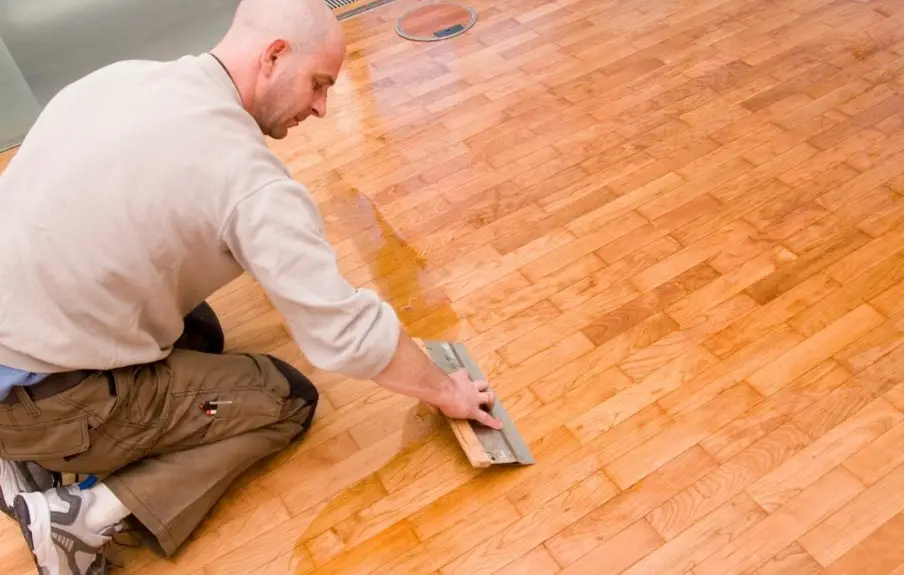
After the first layer, the surface is rubbed along the wood fibers. A few minutes later the second layer is applied, and the surface is grouted across the wood grain.
If the paste is difficult to grout, the paste should be heated.
After both layers have been applied, the surface is given about a day to allow the solvent vapors to evaporate completely.
The surface is then waxed several more times and completely dried.
Finally, the final step is to polish the surface to your desired level with a soft cloth. Sufficiently long polishing can even achieve a mirror-like effect.
Features of Hardwood Floors Waxing
Waxing is an ancient type of wood treatment that is considered one of the noblest. Under the influence of beeswax, wood becomes extraordinarily beautiful, smooth, and soft.
The wax, when applied to the wooden surface, brings out its natural texture, and adds a touch of gloss, a noble yellowish hue can be seen on the surface, and the board exudes a fresh natural scent.
Some masters diligently polish the waxed surface to a mirror shine. Now on sale are a variety of compositions for the treatment of wood with wax.
Among them, you can find, for example, oleoresin wax, which is used in liquid form with the addition of solvent. It is based on beeswax, pine (cedar) resin, and orange oil.
When waxing large areas, such as floors, chemical solvents are added to the solid formulations. However, since the advent of mechanical tools (irons), it is possible to use solids without dissolving them with chemicals.
Today you can find earth-colored wood wax on the building materials market. Use it carefully, because the layer can lie unevenly, it will not be easy to correct.
To change the color of the coating, you should not use earth paint, it is preferable to impregnate the wood with a stain of the appropriate color, rather than oil.
Another useful property of waxed coatings is that they do not accumulate static electricity, and therefore do not attract dust.
It has also been noted that waxed surfaces have a beneficial effect on the emotional and physical well-being of people and create a comfortable atmosphere in the room.
Video: How to Get Wax Off Hardwood Floor
Watch this video if you wanna know how to remove wax buildup on your hardwood floors.
Rules for Working With Wax
By repeating the impregnation procedure several times in succession, you increase the amount of wax per unit area of the wood surface each time.
This gives you the ability to control this parameter as you see fit.
Wood waxing formulations can include several varieties of wax. Among the most famous types let’s name beeswax or carnauba wax, and oleoresin.
There are special artificial products created from the constituents of oil, they contain chemical solvents without an oil base. Here is how to wax a surfboard.

